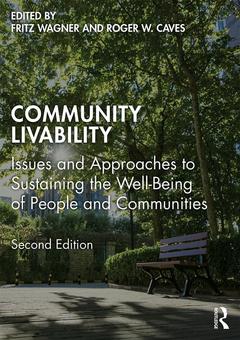Community Livability (2nd Ed.) Issues and Approaches to Sustaining the Well-Being of People and Communities
Coordonnateurs : Wagner Fritz, Caves Roger

What is a livable community? How do you design and develop one? What does government at all levels need to do to support and nurture the cause of livable communities?
Using a blend of theory and practice, the second edition of Community Livability addresses evidence from international, state and local perspectives to explore what is meant by the term "livable communities." The second edition contains new chapters from leading academics and practitioners that examine the various factors that constitute a livable community (e.g., the influence and importance of transportation options/alternatives to the elderly, the importance of walkability as a factor in developing a livable and healthy community, the importance of good open space providing for human activity and health, restorative benefits, etc., the importance of coordinated land use and transportation planning), and the relationship between livability and quality of life. A number of chapters focus on livable communities with case studies from an international perspective in the USA, Canada, Australia, Peru, Sweden, South Korea, Japan, and Austria.
Preface PART I Understanding of Livability Ch 1. Montrealism or Montréalité? Understanding Montreal’s Unique Brand of Livability Ch2. Most Livable Pittsburgh Ch 3. Liveable Stockholm Ch 4. Livable Seoul: Village Community Building Ch 5. The Livable City in the Context of Depopulation in Japan PART II Urban and Regional Planning Issues Ch. 6 How Asheville, North Carolina Has Leveraged Livability as an Urban Development Strategy Ch 7. The Transformation of Seattle Ch 8. Toronto: A Livable City/Region Ch 9. Vienna – Keeping it Livable: How Urban Planning Instruments Contribute to a City’s Quality of Life PART III Issues of Poverty, Equity & the Environment Ch 10. Transit Expansion and the Pursuit of Equity in Development and Growth in Minneapolis – St. Paul, Minnesota Ch 11. Post-Disaster Amenity Politics: Livability, Gentrification, and Recovery in Post-Katrina New Orleans Ch 12. Las Lomas Colonia in Texas: A Livable Community? Ch 13. Lima, a Livable City Ch 14. First We Had to Make It Livable: The Affordances of Livability in Suburban Newcastle, New South Wales, Australia Index
Fritz Wagner has a doctorate in urban and regional planning from the University of Washington. On completion of his degree he moved to New Orleans, where he joined the University of New Orleans. During his 28-year tenure at the University of New Orleans, he served for 20 years as Dean/Director of the College of Urban and Public Affairs. In 2002, he joined the Department of Urban Design and Planning at the University of Washington.
Roger W. Caves is Professor Emeritus of City Planning, School of Public Affairs, San Diego State University. He received his doctorate in urban affairs and public policy from the University of Delaware in 1982. He has authored and edited many planning volumes including Exploring Urban America: An Introductory Reader (1995) and Livable Cities from a Global Perspective (2018) with Fritz Wagner. His research areas include urban planning, direct democracy, smart cities, housing and information technology, and community development.
Date de parution : 08-2019
17.4x24.6 cm
Date de parution : 08-2019
17.4x24.6 cm
Thème de Community Livability :
Mots-clés :
Solar Electricity Generation Systems; communities; Texas Water Development Board; pleasant neighborhoods; GMA; ageing communities; Neighborhood Removal; living together; Regional Growth Plan; social neighborhoods; Increased Job Accessibility; community planning; Rio Grande City; neighbourhood planning; Case Study Suburbs; neighborhood planning; Community Benefit Agreements; transportation planning; Stockholm Royal Seaport; city's walkability; Ministerio Del Ambiente; quality of life; HUD Grant; livable communities; Middle Ring Suburb; African American Respondents; Toronto CMA; Toronto Region; Seoul Metropolitan Government; Waterfront Toronto; Texas Colonias; Regional Transit System; GTA; Starr County; White Respondents; Latin American Cities; Allegheny County



